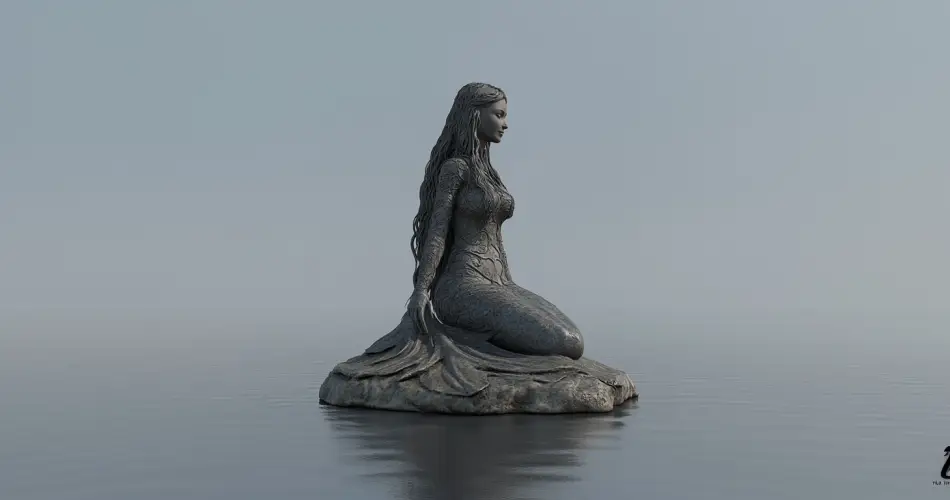Imagine standing on a rocky shoreline, the cold wind whipping around you as waves crash against the coast. You glance toward the water and spot a seal basking on a distant rock, but as you watch closely, something strange happens. The seal slips into the water, and moments later, a human lady emerges from the sea.
You have just seen a Selkie, a mythical shapeshifter that has been a part of Scottish and Irish mythology for centuries. The stories of these mythical creatures are filled with emotion, love, and a relationship between the physical and supernatural worlds.
Join us as we take a closer look at these ancient creatures.
What is a Selkie?
A Selkie is a mythical being that can transform between two forms: a seal in the water and a human on land. The word “Selkie” is derived from the old Celtic word for “seal.” In their natural state, Selkies live as seals in the ocean, but they have the remarkable ability to shed their skin and walk on land as humans.
Unlike other shapeshifting mythical creatures in European mythology, such as Werewolf and Vampires, modern descriptions of the selkies portray them as gentle and alluring creatures. Like seals, they love to visit the shore and bask in the warm light of the sun. During these visits, they remove their seal skin and keep them carefully.
The seal skin of the Selkie is an important totem that is required for transformation. If this skin is stolen or hidden, the Selkie become trapped in human form and is unable to return to the sea. There are several stories of fishermen hiding the skin of beautiful Selkie women and forcing them into marriage.
Origins of the Selkie in Mythology

As enchanting as the Selkie myths are, some scholars believe that these legends might have been born from natural events and human psychology.
One of the more common theories is that the Selkie originated from Norse travellers who visited the ancient Celtic tribes along the coast. These people travelled in kayaks and weird clothing that looked like seal skin to the locals. When the travellers arrived, their clothes were often wet, so they removed them to dry on the rocks at the shoreline.
If these clothes or kayaks are stolen, the travellers will be unable to travel back and will be stuck, just like the mythical Selkies.
The superstitious Celts observed the unique lifestyle of these strangers and created the legend of the Selkie to explain it. As this story is passed from generation to generation, it is modified until it becomes the legend we know today.
Psychological explanations also suggest that Selkie’s stories served as a way for communities to deal with feelings of loss or abandonment. If a fisherman or sailor disappeared at sea, it is easier to believe that the man has gone to join the Selkie than to face the reality of an eternal loss.
Male Selkies
While many Selkie stories centre around female Selkies, male Selkies play an equally important role in the mythology. Male Selkies are often described as handsome, charming, and irresistibly attractive to human women.
Unlike female Selkies, who are forced into relationships with humans, male Selkies actively seek out these relationships. They are particularly attracted to women who are unhappy with their marriages. In some stories, it is the women who summon the Selkies by shedding tears into the sea.
The male selkies do not require their seal skin for transformation and can not be held hostage. However, they can not live on land forever and are forced to return to the sea eventually.
Selkie Stories and Legends
The stories surrounding Selkies revolve around a central theme of reluctant love. They usually involve a man falling in love with a transformed female Selkie. The man steals the Selkie’s skin and forces her to become his wife.
Although the Selkie agree to this demand, she is very unhappy with the marriage and longs for the sea. Eventually, the Selkie recovers her skin and returns to the sea, leaving her human family behind.
Stories like this are common in ancient mythology. They are designed to warn young men against marrying women who are not part of the clan. An example is seen in a famous West African legend of the Sango and a forest spirit.
Powers and Abilities of the Selkie in Mythology
Beyond their ability to shift between the seal and human form, Selkies are believed to possess several supernatural abilities.
Although the Selkies are now seen as docile and weak creatures, earlier records describe them differently. To these ancient Celtic tribes, the Selkies were spirits of the ocean who had the ability to control the ocean and the weather. Fishermen lost at sea were believed to have been taken by these ancient creatures. The Selkie could also navigate the ocean effortlessly and communicate with marine creatures.
Also, it is believed that pregnant women who come in contact with a Selkie will give birth to a child with webbed feet and hands.
Conclusion
The stories of the Selkies are rich in emotion and mystery, reflecting the complex relationship between humans and the sea.
They can be viewed as mythical beings or as symbolic representations of human desires and fears. Their tales of transformation, love, and longing remind us of the powerful forces of nature and the deep connections between humans and the natural world.
As long as there are coasts to walk along and seals to watch, the legend of the Selkie will endure — mysterious, alluring, and ever tied to the call of the sea.
